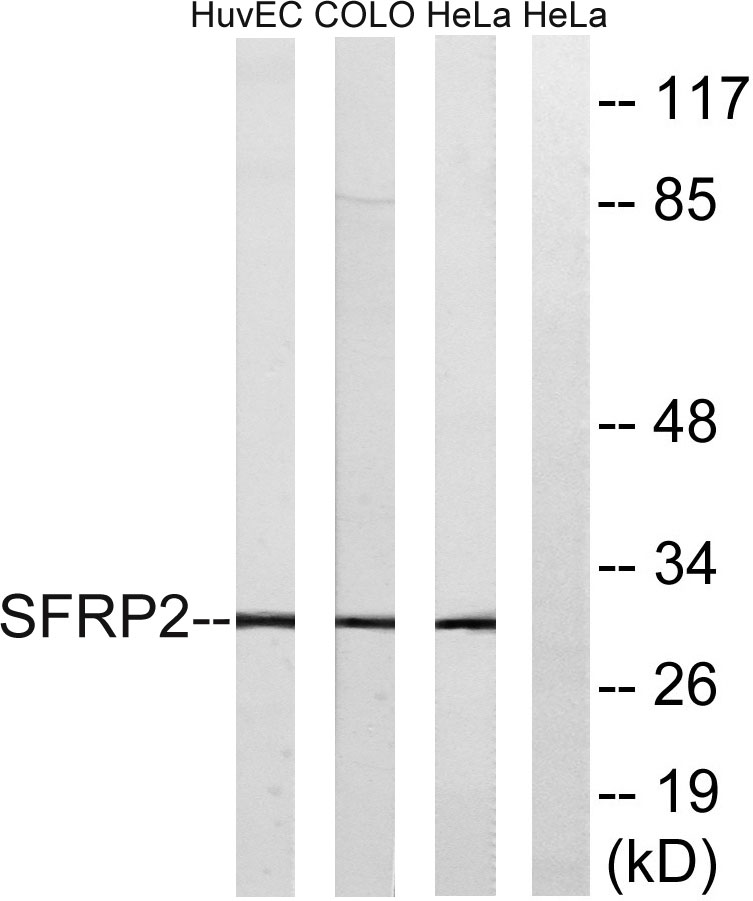FRP-2 Polyclonal Antibody
- Catalog No.:YT1790
- Applications:WB;ELISA
- Reactivity:Human;Mouse;Rat
- Target:
- FRP-2
- Fields:
- >>Wnt signaling pathway
- Gene Name:
- SFRP2
- Protein Name:
- Secreted frizzled-related protein 2
- Human Gene Id:
- 6423
- Human Swiss Prot No:
- Q96HF1
- Mouse Gene Id:
- 20319
- Mouse Swiss Prot No:
- P97299
- Immunogen:
- The antiserum was produced against synthesized peptide derived from human SFRP2. AA range:119-168
- Specificity:
- FRP-2 Polyclonal Antibody detects endogenous levels of FRP-2 protein.
- Formulation:
- Liquid in PBS containing 50% glycerol, 0.5% BSA and 0.02% sodium azide.
- Source:
- Polyclonal, Rabbit,IgG
- Dilution:
- WB 1:500 - 1:2000. ELISA: 1:5000. Not yet tested in other applications.
- Purification:
- The antibody was affinity-purified from rabbit antiserum by affinity-chromatography using epitope-specific immunogen.
- Concentration:
- 1 mg/ml
- Storage Stability:
- -15°C to -25°C/1 year(Do not lower than -25°C)
- Other Name:
- SFRP2;FRP2;SARP1;FKSG12;Secreted frizzled-related protein 2;FRP-2;sFRP-2;Secreted apoptosis-related protein 1;SARP-1
- Observed Band(KD):
- 30kD
- Background:
- This gene encodes a member of the SFRP family that contains a cysteine-rich domain homologous to the putative Wnt-binding site of Frizzled proteins. SFRPs act as soluble modulators of Wnt signaling. Methylation of this gene is a potential marker for the presence of colorectal cancer. [provided by RefSeq, Jul 2008],
- Function:
- domain:The FZ domain is involved in binding with Wnt ligands.,function:Soluble frizzled-related proteins (sFRPS) function as modulators of Wnt signaling through direct interaction with Wnts. They have a role in regulating cell growth and differentiation in specific cell types. SFRP2 may be important for eye retinal development and for myogenesis.,similarity:Belongs to the secreted frizzled-related protein (sFRP) family.,similarity:Contains 1 FZ (frizzled) domain.,similarity:Contains 1 NTR domain.,tissue specificity:Expressed in adipose tissue, heart, brain, skeletal muscle, pancreas, thymus, prostate, testis, ovary, small intestine and colon. Highest levels in adipose tissue, small intestine and colon.,
- Subcellular Location:
- Secreted .
- Expression:
- Expressed in adipose tissue, heart, brain, skeletal muscle, pancreas, thymus, prostate, testis, ovary, small intestine and colon. Highest levels in adipose tissue, small intestine and colon.
- June 19-2018
- WESTERN IMMUNOBLOTTING PROTOCOL
- June 19-2018
- IMMUNOHISTOCHEMISTRY-PARAFFIN PROTOCOL
- June 19-2018
- IMMUNOFLUORESCENCE PROTOCOL
- September 08-2020
- FLOW-CYTOMEYRT-PROTOCOL
- May 20-2022
- Cell-Based ELISA│解您多样本WB检测之困扰
- July 13-2018
- CELL-BASED-ELISA-PROTOCOL-FOR-ACETYL-PROTEIN
- July 13-2018
- CELL-BASED-ELISA-PROTOCOL-FOR-PHOSPHO-PROTEIN
- July 13-2018
- Antibody-FAQs
- Products Images

- Western Blot analysis of various cells using FRP-2 Polyclonal Antibody diluted at 1:500
.jpg)
- Western Blot analysis of HuvEc cells using FRP-2 Polyclonal Antibody diluted at 1:500

- Western blot analysis of lysates from HeLa, COLO, and HUVEC cells, using SFRP2 Antibody. The lane on the right is blocked with the synthesized peptide.



